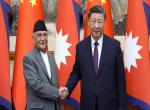This article chronicles the story of the Agni Surface-to-Surface Missile (SSM) from inception till date. In that, it brings out the rationale, as to why we moved from Agni I to Agni II and beyond up to Agni VI, and continuing further. It flags the point as to how this growth story has been a glorious journey of building Comprehensive National Power (CNP) that has, over time, given a great boost to our national pride.
The author's humble claim to write on the subject has been his honour of having one-on-one association with the Agni team under various Project Directors as a Service Headquarters representative from the Military Operations Directorate, including the opportunity to be associated with the team of Bharat Ratna Dr APJ Abdul Kalam - the force behind it all.
Way back in 1982-83, when the Integrated Guided Missile Development Programme (IGDMP) of the DRDO was sanctioned by the Govt for research and development of a comprehensive range of missiles, Agni stood apart only as a Technology Demonstrator (TD) project. In that, while the concurrent development of Prithvi SSM, Trishul Short Range Surface-to-Air Missile (SRSAM), Akash Medium Range SAM (MRSAM), and the Nag third generation anti-tank missile, kicked off on a well-defined milestones and Projected Dates of Completion (PDC), Agni development timeline was left open as is normally demanded by a technology demonstrator.
The initial troubles with Agni (and Prithvi) started way back in 1988-89 when the firsts of their prototype with targeted ranges in the region of 300 km and more (Prithivi I -150 km and Agni I - 700-1250 km) got tested. At this time, the Missile Technology Control Regime (MTCR) decided to put restrictions on India's access to missile technology that would take forward its missile development programme1,2. The purpose of stating this point is to drive home the point that the entire Agni story set off its journey on a technology denial regime.
In fact, it was on the strength of the competence and expertise built by the Defence Research and Development Laboratory (DRDL) in the field of propulsion, navigation and aerospace materials based on soviet technology, along with the expertise and charisma brought in by the then Project Director of IGMDP, Dr Kalam of SLV-3 fame, duly assisted by his worthy scientists, that provided the seed which actually bloomed with a sense of stubborn determination - 'we will do it on our own'. To that end, the MTCR restrictions actually proved to be a kind of catalyst in our quest to develop and consolidate various technologies into 'capabilities'.
Coming back to Agni, the initial TD version had a limited scope of developing the re-entry technologies. Over a period of time, this got expanded to building Medium Range Ballistic Missiles (MRBM) and further down the time line, it took the shape of a national level project for building Intercontinental Range Ballistic Missiles (ICBM). There was a definitive operational need for each step forward in the Agni journey as the text will show, as it unfolds.
There is no point in making such distinctions as Prithvi for Pakistan and Agni for China, simply because it is not as binary and as clear-cut as that. These SSMs are the components of Comprehensive National Power (CNP) whose subset, Comprehensive Military Power (CMP), gets shaped over time based on the instant threat perception and the ever-changing contours of geo-politics and geo-strategy in our immediate and extended neighbourhood. It makes far more sense to connect the Agni story with the 'Credible Nuclear Deterrence' as a pillar of our nuclear doctrine.
As is well known, India's nuclear doctrine is based on the central pillar of ‘No First Use’ or NFU with a promise of massive retaliation causing unacceptable damage to any aggressor who indulges in a nuclear attack on Indian territory or on Indian forces anywhere3. This posture demands a survivable and credible nuclear deterrent whose three strategic pillars are - warheads, delivery ‘triad’ (means to deliver nuclear warheads from land sea and air) and command and control structure. The decision to move beyond the technology demonstrator into a full-fledged missile programme can rightly be seen in the context of developing of the main pillars of our strategic nuclear deterrent. Agni is neither Pakistan-centric nor China-centric; it is centric to our nuclear deterrence.
Interestingly, the first of the series of Agni to be developed was not Agni I but Agni II, tested for the first time in 1989 soon after India carried out its first nuclear weapon test in 1998. The range of 2000-3500 km using two half-stage solid propellant motors and a capability to carry nuclear as well as conventional warhead between 750-1000 kg was related to technology thresholds that could be harnessed at that point in time. It had also a significant capability of re-entry with altitude control system and aerodynamic manoeuvre fins which allowed it to execute a non-ballistic trajectory that is always difficult to intercept. The TD target of harnessing the re-entry technology was thus realised. Its range, across the western borders went well beyond Pakistan into our extended neighbourhood while on the North it remained restricted to only to southern China4.
Having realised the 2000-3500 km range with Agni II and up to 350-600 km with Prithvi III by around the turn of the Millennium, a gap between the above ranges and reach brackets came to be realised during the Kargil War. Need for a ballistic missile in the mid-range (implying a bracket between Agni II and Prithiv III ) was thus felt. That operational need was addressed in Jan 2002 when Agni I version was tested for the first time. This MRBM had a range bracket of 700-1250 km with a capability to carry nuclear as well as conventional warheads. Having come after Agni II, the fuel stage was advanced to a single stage solid propellant and the Circular Error of Probability (CEP) marginally improved from 30 to 25 m.
The shift up from the Agni II MRBM to Agni III Intermediate Range Ballistic Missile (IRBM) came about for a few specific reasons. First of course was to increase the reach capability with regards to targets in the Chinese mainland. Second was the demand on accuracy. In around the time bracket of 2005-09, the emphasis world over was to develop smaller yield nuclear weapons. Experts believed that a number of smaller yield warheads spread over an area were going to be far more effective than a megaton monster at one place with totally unthinkable collateral damage. If a 200 kilo ton had to be effective instead of a 2 meg ton weapon, the warhead needed to be delivered very accurately. This was the requirement of this missile. Accordingly, Agni III, test fired in 2011, achieved an incredible few meter accuracy though the slated CEP was 40 m. In any case, an IRBM with a range bracket of 3500-5000 km to have a slated CEP of 40 m made it the most accurate IRBM in the world! There were some other firsts scored in Agni III:-
- To bring in precision accuracy in measurement of angular rotation of the missile, a Ring Laser Gyro (RLG) was incorporated. RLG features two independent laser beams of same polarisation travelling in opposite directions (counter propagating in resonant modes) in a closed loop. When there is no angular rotation, the frequency of the two waves are equal. Slightest angular rotation taking place in the missile-in-flight brings in a variation in the frequency of the two laser beams. This variation is the measure of the quantum of angular rotation. The difference in the frequency of the two waves is owing to the fact, that post angular rotation, the apparent distance travelled by one wave to reach its home station with reference to the start is longer than the other. Such precise measurements result in adding to incredible CEPs of the missile, as stated above. 5
- The missile can carry a heavier payload and has a longer range but still it is in a more compact configuration than its predecessor (Agni II - length 21 m , diameter - 1.3 m, Agni III – length 17 m , diameter - 2.0 m). A thicker and a shorter configuration ensures that the said missile is more effective in defeating anti ballistic missile (ABM) defences of the adversary. For this capability, it also carries along with main warhead, an ABM counter-measure payload and state-of-the-art decoys. 6
- Weight reduction has been achieved by making use of maraging steel. This type of steel has superior strength and toughness than normal steel and possesses higher malleability.
In graduating from Agni III to Agni IV, the foremost consideration was the Multiple Independently Targetable Re-Entry Vehicles (MIRV) technology. This could enable multiple nuclear warheads to be carried each of which could be independently programmed for target data, thus posing a huge challenge to the adversary's Anti Ballistic Missile (ABM) systems. Several other firsts with this missile are as under:-
- For the first time, a missile flew with two complementing and redundant guidance systems: One indigenous Ring Laser Gyro based very accurate Inertial Navigation System (INS), or RINS, and the other, a Micro Navigation System (MINGS).
- The missile was fitted with composite rocket motors. This breakthrough technology used composite materials in motor casing designs, and utilised composite solid propellants to produce higher thrusts and higher accuracy at lower costs. This level of accuracy was further enhanced by steerable nozzles and divert and attitude control motors.
- The revamped Information Technology (IT) pack featured the new digital controller system and a very powerful on-board computer system.
- In the successful test on 03 Jan 17, the missile was specifically programmed for a range of 3100 km, while its two earlier launches had been programmed at 3000 and 3500 km under the designed range cap of 4000+ km. These programmed ranges have been achieved with very high accuracies.
Our entry into the very exclusive ICBM club commenced from Apr 2012 when the first ever launch of the 5500-8000 km range Agni V took place. Capable of carrying 3-10 MIRVed warheads on the power train provided by three-stage solid propellant composite motors heralded a new era of our strategic range and reach capability; it also provided a strong arm in the nuclear triad delivery system. Its fourth and latest launch on 26 Dec 16 proved the missile fully with the following innovative features:-
- The missile has a canister based configuration carved out of maraging steel in a hermetically sealed condition. This provides incredible road mobility for a missile of 50 tons that stands 17.5 m tall with a comparatively thick diameter of 2 m.
- For a missile of ICBM range to have achieved single digit accuracy (second launch report 15 Sep 2013) is truly incredible; made possible by the RINS. MINGS, RLGs, accelerometers (for measuring vibrations in rotating machines) and a powerful on board computer suite.
Moving ahead on the road of capability-building, the nation is looking at Agni VI with a slated range of 8000-12000 km and powered by a four-stage solid fuelled engine. The missile is slated to be flight tested in 2017 though the Government is yet to approve the project. Capable of carrying up to 10 MIRVs, the warheads would have the capability of taking evasive manoeuvres to confuse adversary's air defence missiles and then come hurtling down on the programmed targets in the form of Manoeuvrable RVs (MARV). The submarine launched version of the missile (SLBM) will arm the Arihant class submarines of the Indian Navy. Some salient features of this missile are:-
- The RINS and MINGS systems on board will be duly linked with the Indian Regional Navigation Satellite System (IRNSS).
- The state-of-the-art technology of Radar Scene Correlation will enhance accuracy at the target end.
- With this range, all targets in the immediate and extended neighbourhood would fall within the strike range.
There are unconfirmed reports of development of a new ICBM, Surya (range 12000-16000 km) which would be capable of carrying 3-10 MARVs. 7
There are reports of a new type of beginning where missiles designed in the nineties are being re-visited with newer technologies developed for Agni III/IV/V. In this context, there are reports of a new missile named Agni IP, configured on the original Agni I (range 300-700 m), but configured with such technologies as described for the later versions. It is reported that Agni IP will replace its vintage predecessor, Agni I.
Thus goes the story of Agni - a saga of our national pride.
(The author is a former Director General of Army Air Defence)
End Notes
i. The Agni story is one glorious chapter of building Comprehensive National Power that has enhanced our national pride, immensely.
ii. The development has been on a brick-on-brick concept with a clear logic and rationale in moving from I to II to III and on to VI and counting.
iii. It is incorrect to link Agni to any specific country or worse still, to talk of the binary - Prithvi for Pakistan and Agni for China. Agni is essentially a component of our nuclear deterrent and constitutes the long arm of the delivery triad.
iv. With Agni VI at 12,000 km and the reported (but unconfirmed) report on Surya ICBM, the ranges required for our nuclear deterrent to be effective in our immediate and extended neighbourhood stand achieved. The author is of the view that there may not be a requirement of further range escalation. The more viable step will be the one on the lines of Agni 1 P.
v. It is well known that China has ICBMs of the ranges significantly greater than Agni VI range ( DF 5A - 13000+ km, DF 41 - 12000-15000 km), two points are relevant. One, in the deterrence game, you don't match km to km or warhead to warhead so long as you have the range and reach that covers your targets of interest and that the capability is credible. Second, the Chinese game of deterrence is basically westward to US, India hardly gets a credence as a viable nuclear power ( not explained further).
References
- https://www.quora.com> mtcr.
- T S Subramanian. Missile shield Frontline Jan 2009.
- https://www.csis.org>analysis.india's nuclear doctrine.
- https://www.carnegieendowment.org>india-missile-deployment-and-reaction-from-china.
- https;//www.airspacemag.com.how-things-work-ring-laser-gyro.
- https://www.armytechnology.com>agni III.
- https://www.en.m. wikipedidia.com> surya missile
This article chronicles the story of the Agni Surface-to-Surface Missile (SSM) from inception till date. In that, it brings out the rationale, as to why we moved from Agni I to Agni II and beyond up to Agni VI, and continuing further. It flags the point as to how this growth story has been a glorious journey of building Comprehensive National Power (CNP) that has, over time, given a great boost to our national pride.
The author's humble claim to write on the subject has been his honour of having one-on-one association with the Agni team under various Project Directors as a Service Headquarters representative from the Military Operations Directorate, including the opportunity to be associated with the team of Bharat Ratna Dr APJ Abdul Kalam - the force behind it all.
Way back in 1982-83, when the Integrated Guided Missile Development Programme (IGDMP) of the DRDO was sanctioned by the Govt for research and development of a comprehensive range of missiles, Agni stood apart only as a Technology Demonstrator (TD) project. In that, while the concurrent development of Prithvi SSM, Trishul Short Range Surface-to-Air Missile (SRSAM), Akash Medium Range SAM (MRSAM), and the Nag third generation anti-tank missile, kicked off on a well-defined milestones and Projected Dates of Completion (PDC), Agni development timeline was left open as is normally demanded by a technology demonstrator.
The initial troubles with Agni (and Prithvi) started way back in 1988-89 when the firsts of their prototype with targeted ranges in the region of 300 km and more (Prithivi I -150 km and Agni I - 700-1250 km) got tested. At this time, the Missile Technology Control Regime (MTCR) decided to put restrictions on India's access to missile technology that would take forward its missile development programme1,2. The purpose of stating this point is to drive home the point that the entire Agni story set off its journey on a technology denial regime.
In fact, it was on the strength of the competence and expertise built by the Defence Research and Development Laboratory (DRDL) in the field of propulsion, navigation and aerospace materials based on soviet technology, along with the expertise and charisma brought in by the then Project Director of IGMDP, Dr Kalam of SLV-3 fame, duly assisted by his worthy scientists, that provided the seed which actually bloomed with a sense of stubborn determination - 'we will do it on our own'. To that end, the MTCR restrictions actually proved to be a kind of catalyst in our quest to develop and consolidate various technologies into 'capabilities'.
Coming back to Agni, the initial TD version had a limited scope of developing the re-entry technologies. Over a period of time, this got expanded to building Medium Range Ballistic Missiles (MRBM) and further down the time line, it took the shape of a national level project for building Intercontinental Range Ballistic Missiles (ICBM). There was a definitive operational need for each step forward in the Agni journey as the text will show, as it unfolds.
There is no point in making such distinctions as Prithvi for Pakistan and Agni for China, simply because it is not as binary and as clear-cut as that. These SSMs are the components of Comprehensive National Power (CNP) whose subset, Comprehensive Military Power (CMP), gets shaped over time based on the instant threat perception and the ever-changing contours of geo-politics and geo-strategy in our immediate and extended neighbourhood. It makes far more sense to connect the Agni story with the 'Credible Nuclear Deterrence' as a pillar of our nuclear doctrine.
As is well known, India's nuclear doctrine is based on the central pillar of ‘No First Use’ or NFU with a promise of massive retaliation causing unacceptable damage to any aggressor who indulges in a nuclear attack on Indian territory or on Indian forces anywhere3. This posture demands a survivable and credible nuclear deterrent whose three strategic pillars are - warheads, delivery ‘triad’ (means to deliver nuclear warheads from land sea and air) and command and control structure. The decision to move beyond the technology demonstrator into a full-fledged missile programme can rightly be seen in the context of developing of the main pillars of our strategic nuclear deterrent. Agni is neither Pakistan-centric nor China-centric; it is centric to our nuclear deterrence.
Interestingly, the first of the series of Agni to be developed was not Agni I but Agni II, tested for the first time in 1989 soon after India carried out its first nuclear weapon test in 1998. The range of 2000-3500 km using two half-stage solid propellant motors and a capability to carry nuclear as well as conventional warhead between 750-1000 kg was related to technology thresholds that could be harnessed at that point in time. It had also a significant capability of re-entry with altitude control system and aerodynamic manoeuvre fins which allowed it to execute a non-ballistic trajectory that is always difficult to intercept. The TD target of harnessing the re-entry technology was thus realised. Its range, across the western borders went well beyond Pakistan into our extended neighbourhood while on the North it remained restricted to only to southern China4.
Having realised the 2000-3500 km range with Agni II and up to 350-600 km with Prithvi III by around the turn of the Millennium, a gap between the above ranges and reach brackets came to be realised during the Kargil War. Need for a ballistic missile in the mid-range (implying a bracket between Agni II and Prithiv III ) was thus felt. That operational need was addressed in Jan 2002 when Agni I version was tested for the first time. This MRBM had a range bracket of 700-1250 km with a capability to carry nuclear as well as conventional warheads. Having come after Agni II, the fuel stage was advanced to a single stage solid propellant and the Circular Error of Probability (CEP) marginally improved from 30 to 25 m.
The shift up from the Agni II MRBM to Agni III Intermediate Range Ballistic Missile (IRBM) came about for a few specific reasons. First of course was to increase the reach capability with regards to targets in the Chinese mainland. Second was the demand on accuracy. In around the time bracket of 2005-09, the emphasis world over was to develop smaller yield nuclear weapons. Experts believed that a number of smaller yield warheads spread over an area were going to be far more effective than a megaton monster at one place with totally unthinkable collateral damage. If a 200 kilo ton had to be effective instead of a 2 meg ton weapon, the warhead needed to be delivered very accurately. This was the requirement of this missile. Accordingly, Agni III, test fired in 2011, achieved an incredible few meter accuracy though the slated CEP was 40 m. In any case, an IRBM with a range bracket of 3500-5000 km to have a slated CEP of 40 m made it the most accurate IRBM in the world! There were some other firsts scored in Agni III:-
- To bring in precision accuracy in measurement of angular rotation of the missile, a Ring Laser Gyro (RLG) was incorporated. RLG features two independent laser beams of same polarisation travelling in opposite directions (counter propagating in resonant modes) in a closed loop. When there is no angular rotation, the frequency of the two waves are equal. Slightest angular rotation taking place in the missile-in-flight brings in a variation in the frequency of the two laser beams. This variation is the measure of the quantum of angular rotation. The difference in the frequency of the two waves is owing to the fact, that post angular rotation, the apparent distance travelled by one wave to reach its home station with reference to the start is longer than the other. Such precise measurements result in adding to incredible CEPs of the missile, as stated above. 5
- The missile can carry a heavier payload and has a longer range but still it is in a more compact configuration than its predecessor (Agni II - length 21 m , diameter - 1.3 m, Agni III – length 17 m , diameter - 2.0 m). A thicker and a shorter configuration ensures that the said missile is more effective in defeating anti ballistic missile (ABM) defences of the adversary. For this capability, it also carries along with main warhead, an ABM counter-measure payload and state-of-the-art decoys. 6
- Weight reduction has been achieved by making use of maraging steel. This type of steel has superior strength and toughness than normal steel and possesses higher malleability.
In graduating from Agni III to Agni IV, the foremost consideration was the Multiple Independently Targetable Re-Entry Vehicles (MIRV) technology. This could enable multiple nuclear warheads to be carried each of which could be independently programmed for target data, thus posing a huge challenge to the adversary's Anti Ballistic Missile (ABM) systems. Several other firsts with this missile are as under:-
- For the first time, a missile flew with two complementing and redundant guidance systems: One indigenous Ring Laser Gyro based very accurate Inertial Navigation System (INS), or RINS, and the other, a Micro Navigation System (MINGS).
- The missile was fitted with composite rocket motors. This breakthrough technology used composite materials in motor casing designs, and utilised composite solid propellants to produce higher thrusts and higher accuracy at lower costs. This level of accuracy was further enhanced by steerable nozzles and divert and attitude control motors.
- The revamped Information Technology (IT) pack featured the new digital controller system and a very powerful on-board computer system.
- In the successful test on 03 Jan 17, the missile was specifically programmed for a range of 3100 km, while its two earlier launches had been programmed at 3000 and 3500 km under the designed range cap of 4000+ km. These programmed ranges have been achieved with very high accuracies.
Our entry into the very exclusive ICBM club commenced from Apr 2012 when the first ever launch of the 5500-8000 km range Agni V took place. Capable of carrying 3-10 MIRVed warheads on the power train provided by three-stage solid propellant composite motors heralded a new era of our strategic range and reach capability; it also provided a strong arm in the nuclear triad delivery system. Its fourth and latest launch on 26 Dec 16 proved the missile fully with the following innovative features:-
- The missile has a canister based configuration carved out of maraging steel in a hermetically sealed condition. This provides incredible road mobility for a missile of 50 tons that stands 17.5 m tall with a comparatively thick diameter of 2 m.
- For a missile of ICBM range to have achieved single digit accuracy (second launch report 15 Sep 2013) is truly incredible; made possible by the RINS. MINGS, RLGs, accelerometers (for measuring vibrations in rotating machines) and a powerful on board computer suite.
Moving ahead on the road of capability-building, the nation is looking at Agni VI with a slated range of 8000-12000 km and powered by a four-stage solid fuelled engine. The missile is slated to be flight tested in 2017 though the Government is yet to approve the project. Capable of carrying up to 10 MIRVs, the warheads would have the capability of taking evasive manoeuvres to confuse adversary's air defence missiles and then come hurtling down on the programmed targets in the form of Manoeuvrable RVs (MARV). The submarine launched version of the missile (SLBM) will arm the Arihant class submarines of the Indian Navy. Some salient features of this missile are:-
- The RINS and MINGS systems on board will be duly linked with the Indian Regional Navigation Satellite System (IRNSS).
- The state-of-the-art technology of Radar Scene Correlation will enhance accuracy at the target end.
- With this range, all targets in the immediate and extended neighbourhood would fall within the strike range.
There are unconfirmed reports of development of a new ICBM, Surya (range 12000-16000 km) which would be capable of carrying 3-10 MARVs. 7
There are reports of a new type of beginning where missiles designed in the nineties are being re-visited with newer technologies developed for Agni III/IV/V. In this context, there are reports of a new missile named Agni IP, configured on the original Agni I (range 300-700 m), but configured with such technologies as described for the later versions. It is reported that Agni IP will replace its vintage predecessor, Agni I.
Thus goes the story of Agni - a saga of our national pride.
(The author is a former Director General of Army Air Defence)
End Notes
i. The Agni story is one glorious chapter of building Comprehensive National Power that has enhanced our national pride, immensely.
ii. The development has been on a brick-on-brick concept with a clear logic and rationale in moving from I to II to III and on to VI and counting.
iii. It is incorrect to link Agni to any specific country or worse still, to talk of the binary - Prithvi for Pakistan and Agni for China. Agni is essentially a component of our nuclear deterrent and constitutes the long arm of the delivery triad.
iv. With Agni VI at 12,000 km and the reported (but unconfirmed) report on Surya ICBM, the ranges required for our nuclear deterrent to be effective in our immediate and extended neighbourhood stand achieved. The author is of the view that there may not be a requirement of further range escalation. The more viable step will be the one on the lines of Agni 1 P.
v. It is well known that China has ICBMs of the ranges significantly greater than Agni VI range ( DF 5A - 13000+ km, DF 41 - 12000-15000 km), two points are relevant. One, in the deterrence game, you don't match km to km or warhead to warhead so long as you have the range and reach that covers your targets of interest and that the capability is credible. Second, the Chinese game of deterrence is basically westward to US, India hardly gets a credence as a viable nuclear power ( not explained further).
References
- https://www.quora.com> mtcr.
- T S Subramanian. Missile shield Frontline Jan 2009.
- https://www.csis.org>analysis.india's nuclear doctrine.
- https://www.carnegieendowment.org>india-missile-deployment-and-reaction-from-china.
- https;//www.airspacemag.com.how-things-work-ring-laser-gyro.
- https://www.armytechnology.com>agni III.
- https://www.en.m. wikipedidia.com> surya missile








